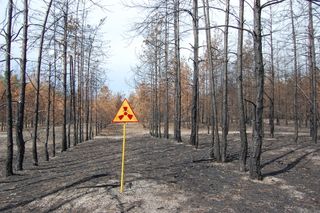Chernobyl Trees Barely Decomposed, Study Finds

Almost 30 years ago, the world's attention was fixed on Chernobyl, the nuclear power plant in Ukraine that exploded in one of the world's worst nuclear disasters.
The world has moved on since that 1986 catastrophe, but at Chernobyl, one thing hasn't changed very much: The dead trees, plants and leaves at the contaminated site don't decay at nearly the same rate as plants elsewhere, researchers have found.
"We were stepping over all these dead trees on the ground that had been killed by the initial blast," Tim Mousseau, a professor of biology at the University of South Carolina, said in a statement. "Years later, these tree trunks were in pretty good shape. If a tree had fallen in my backyard, it would be sawdust in 10 years or so." [Images: Chernobyl, Frozen in Time]
Mousseau and Anders Møller of the Université Paris-Sud have made ongoing investigations into the biology of radioactive areas like Chernobyl and Fukushima, Japan.
Much of their work has taken them into the Red Forest, the infamous wooded region surrounding Chernobyl where the trees turned an ominous reddish-brown color before dying. The pair noticed that the tree trunks seemed largely unchanged, even after a few decades.
"Apart from a few ants, the dead tree trunks were largely unscathed when we first encountered them," Mousseau, who is also co-director of the Chernobyl and Fukushima Research Initiatives at the University of South Carolina, told Smithsonian.
To find out what was happening — or, more accurately, what wasn't happening — the research team collected hundreds of samples of leaf litter from forest floors that were not contaminated by radiation and stuffed the leaves into bags lined with panty hose (to keep out insects). They then distributed these bags around the Chernobyl area and waited nine months.
Sign up for the Live Science daily newsletter now
Get the world’s most fascinating discoveries delivered straight to your inbox.
The results were striking: Samples of leaf litter that were placed in highly contaminated areas showed 40 percent less decomposition than samples that were placed in uncontaminated sites. The degree of decay was proportional to the degree of radioactive contamination at each site, according to the study, published in the journal Oecologia.
Radiation is known to have harmful effects on microorganisms such as bacteria and fungi. Recent research has found that radiation therapy can cause severe complications in cancer patients by reducing the populations of helpful bacteria in the intestines. [Infographic: How Radiation Affects the Human Body]
Mousseau and other researchers are concerned that the buildup of leaf litter on the forest floor presents a real danger. "There is growing concern that there could be a catastrophic fire in the coming years," Mousseau said.
In the event of a forest fire, 28 years' worth of undecayed leaves would provide an ideal fuel for the fire, which could then spread radiation throughout the region. "That would end up moving radiocesium and other contaminants via smoke into populated areas," Mousseau said.
"This litter accumulation that we measured, which is likely a direct consequence of reduced microbial decomposing activity, is like kindling," Mousseau added. "It's dry, light and burns quite readily. It adds to the fuel, as well as makes it more likely that catastrophically sized forest fires might start."
Follow Marc Lallanilla on Twitter and Google+. Follow us @livescience, Facebook & Google+. Original article on Live Science.

